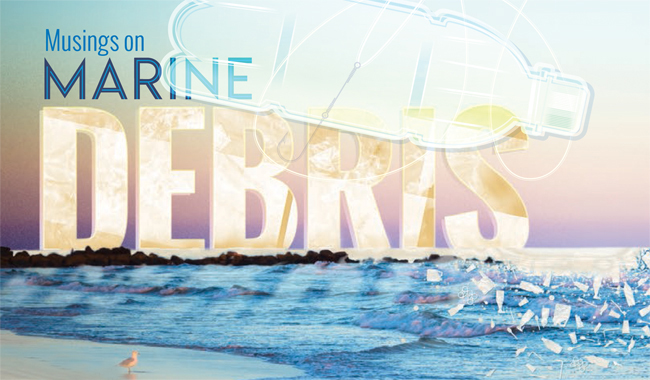
— By Krista Haas; Published in NYSDEC's The Conservationist - April 2020
Stony Brook, NY, May 12, 2020 - Chances are you’ve probably noticed trash in the environment — by the side of the road, pouring out of an overflowing bin, caught in a storm drain, left on the beach, or in a number of other places. Chances are that you’ve noticed it recently too, perhaps even today. Unfortunately, sights like this are now part of our everyday lives. While they may warrant a reaction of “Ugh, that’s disgusting,” more often than not, we’ve become so desensitized to it that we barely notice. However, occasionally we might pause and think:
What happens to this garbage littering our communities? How did it get there? Whose responsibility is it to clean it up? And, who can help make sure that these places stay clean?
Well, let’s explore.
What happens to loose trash?
Although some of the trash we see in our environment may get picked up and be properly disposed, a lot of it doesn’t. That trash may continue to move around and eventually end up in our waterways, becoming what is commonly referred to as “marine debris.”
Marine debris is officially defined as “any persistent solid material that is manufactured or processed and directly or indirectly, intentionally or unintentionally, disposed of or abandoned into the marine environment or the Great Lakes.”
To put it in simpler terms, it’s solid trash in the ocean or the Great Lakes. That means that the term “marine debris” can refer to almost any manmade waste, ranging from teeny pieces of foamed plastic to old fishing lines, plastic water bottles, or even a large abandoned vessel.
Once these discarded items enter our waters, they can have quite an impact. Debris can harm animals by resembling their natural food and being accidentally ingested, filling their stomachs or blocking their digestive system. There is also the physical hazard of entanglement, resulting in anything from mild irritation to death. In addition, debris can smother or destroy critical habitat by reducing light and oxygen levels, create serious navigational hazards for both recreational boaters and commercial vessels, and even impact our health.
In addition, marine debris can negatively impact coastal economies as it continues to clutter our shores and mar the beautiful aesthetic qualities of these destinations, causing the number of visitors to coastal communities to dwindle in favor of cleaner locales. In fact, a 2019 study by the National Oceanic and Atmospheric Administration (NOAA) found that marine debris had a substantial economic impact and that doubling levels of marine debris along Mid-Atlantic coasts could result in losses of more than $140 million in recreational value, more than $250 million in tourism spending, and 3,400 jobs.
Unfortunately, the economic impacts of marine debris don’t stop there. Lost or discarded fishing gear can impact commercial fishing revenues as it continues to capture marine life, which unfortunately often perishes due to the gear no longer being checked. This is especially true for derelict pots and traps, where deceased animals become “fresh bait” and lure in additional animals that could otherwise be fished and sold by commercial fisheries.
A 2015 NOAA study found that removal of some of the estimated 145,000 derelict crab pots in the Chesapeake Bay could increase the crab harvest by 38 million pounds (accounting for 28.3 percent of the annual harvest), and that six years of this type of removal could produce an additional $33.5 million for the fishery.
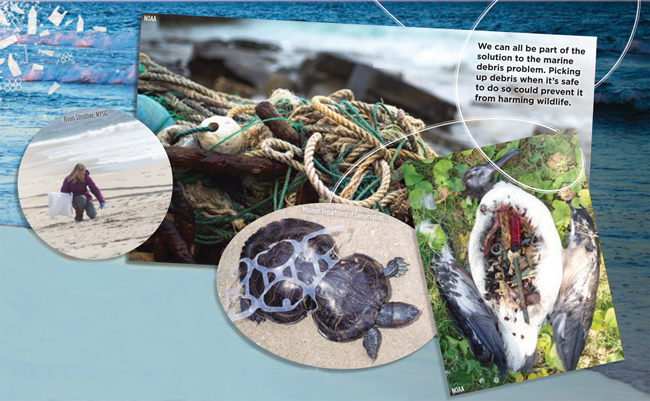
How does it get there?
All this debris can enter our environment in many ways. Someone may have left their belongings behind while visiting the beach or a park, maybe items blew away with the wind before someone was able to discard of them properly, or maybe somebody put their trash in a garbage can that was overflowing or it got knocked over.
Of course, garbage also gets into the environment from people intentionally littering; but in many cases, it’s accidental, simply because we’re just not paying enough attention. For instance, many people would be appalled at the thought of littering, but they wouldn’t think twice about releasing a balloon into the air or adding their trash to the top of a heaping mound of rubbish in a too-full public garbage can.
However, it’s our responsibility to reduce our contributions, including making sure that we’re discarding our trash properly. That responsibility falls on all of us, not just those living in coastal communities.
Although coastal communities may be on the front lines of the marine debris problem, inlanders have just as much of a stake in the fight. Marine debris may feel like a far-off problem when you’re located inland, but in reality, it comes from and impacts us all. The reason is simple: watersheds.
A watershed is an area of land that drains into the same waterbody. Some watersheds can be huge. For example, did you know that parts of New York State are in the watershed that drains into the Chesapeake Bay, about 250 miles away?
That means that trash from parts of New York State can be carried through the watershed all the way to the Chesapeake Bay, which is directly connected to the ocean. And that’s just one example.
No matter where you are, your trash can end up as marine debris.
What can we do about it?
Thankfully, there’s a lot we can do about the marine debris issue. Considering this is a problem entirely caused by humans, that means that it’s an issue that is fully preventable, and we have the power to tackle it. Although addressing marine debris can feel like a daunting task, and you may be wondering what kind of difference you can possibly make as an individual, you would be amazed at what small actions can accomplish. The impact of cumulative small efforts will grow exponentially as more and more people take action.
The most important step toward addressing marine debris is prevention, or “turning off the tap.” We must first stop the problem from getting worse, then we need to address the damage that’s been done—like an overflowing sink, you’d start by turning off the faucet before cleaning up the mess. We can prevent more marine debris by making small changes in the ways that we live our lives, like filling a reusable bottle with water rather than buying a plastic water bottle. We can also take steps to reduce our use of throw-away materials whenever possible, reuse items when we’re able, and if we do use something that must be discarded, recycle it if we can.
New York’s recent plastic bag ban is a great example of an effort to reduce our use of disposable plastic items and replace them with reusable items instead.
As we take steps to prevent contributing to marine debris, we can also spread the word about the issue and our efforts to our friends, family, and community. Educating others about the problem and how they can make a difference is essential to preventing marine debris and changing social norms.
Unfortunately, as we’re working on turning off that tap, there is already quite a mess to deal with. To address the marine debris that’s already out there, we must also focus on removal.
By removing trash that’s in our environment, we can prevent it from inflicting additional damage and make our spaces more beautiful in the process. There are many efforts to do this at various scales, but you can work to make a difference by participating in a cleanup in your community.
Check for events near you and join a local effort. If you can’t find a cleanup to join, consider getting some friends together and organizing one yourself. Or, simply take a bag with you on your next walk and pick up debris as you go. There are lots of ways to get involved, and every effort makes a difference.
So, the next time you’re walking or driving down the street and you notice some trash that shouldn’t be there, ask yourself if you’re contributing to the problem, ignoring it, or helping to solve it. If you don’t like your answer, now is the perfect time to change it.

Plastics and the Environment
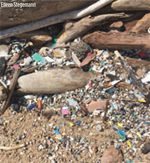 Plastic sticks around. That’s why it was quite the miracle product when it first came into the spotlight—cheap to manufacture, lightweight, and doesn’t fall apart. Unfortunately, these same properties are the reason plastic is currently causing such a problem in our ocean—it never really goes away. Instead, plastic items break down into smaller and smaller pieces as they’re exposed to the elements, eventually becoming “microplastics,” which are difficult to clean and easily ingested by wildlife.
Plastic sticks around. That’s why it was quite the miracle product when it first came into the spotlight—cheap to manufacture, lightweight, and doesn’t fall apart. Unfortunately, these same properties are the reason plastic is currently causing such a problem in our ocean—it never really goes away. Instead, plastic items break down into smaller and smaller pieces as they’re exposed to the elements, eventually becoming “microplastics,” which are difficult to clean and easily ingested by wildlife.
Although plastics still have a valuable place in our society, such as in the medical field, a vast amount of unnecessary plastic is used every day and approximately eight million metric tons of plastic waste enters our ocean each year. Think about what unnecessary plastic items you use in your life and consider making the switch to environmentally friendly alternatives.
Photo: Plastic debris litters a Lake Ontario beach. Credit: Eileen Stegemann.
Marine Debris in New York
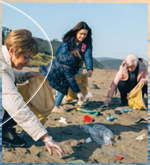 New York relies on the ocean and its waters for a wide range of commercial and recreational activities. However, marine debris is a problem around the globe and unfortunately, New York is no exception.
New York relies on the ocean and its waters for a wide range of commercial and recreational activities. However, marine debris is a problem around the globe and unfortunately, New York is no exception.
During the 2018 International Coastal Cleanup, volunteers collected 295,742 debris items from more than 316 miles in New York. That included more than 32,000 cigarette butts (those filters are made of a plastic-like substance that doesn’t break down), more than 23,400 plastic bottle caps, and more than 13,500 plastic water bottles. During a similarly timed cleanup of Jones Beach on Long Island, a separate group collected more than 470 pieces of balloon-related debris items from just one mile of beach.
That’s a lot of debris!
For more information, see the International Coastal Cleanup.
Photo: Joining a community cleanup is a great way to help address the marine debris problem in your area; every individual action makes a difference.
The Truth about the Great Pacific Garbage Patch
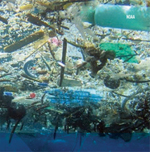 The “Great Pacific Garbage Patch” has become quite the celebrity over the years, and as with any famous figure, there are a lot of rumors out there.
The “Great Pacific Garbage Patch” has become quite the celebrity over the years, and as with any famous figure, there are a lot of rumors out there.
Let’s set the record straight. The “Great Pacific Garbage Patch” is actually just one of several “garbage patches” found around the world.
No, these patches are not huge floating masses of garbage that you can walk on. Instead, they are where large amounts of marine debris can be found in greater densities due to circular ocean currents called “gyres” that concentrate trash in these areas.
This concentrated collection of debris can be found from the surface of the water, throughout the water column, and all the way down to the bottom of the ocean. And while the garbage patches do include larger pieces of debris, like fishing nets and plastic containers, these patches are mostly made up of very small plastic pieces.
As you can imagine, this makes the garbage patches very difficult to clean, which is why efforts to address marine debris are mostly focused on preventing more trash from entering our ocean and cleaning up coasts and nearshore waters.
Krista Haas is the Ocean & Marine Outreach Coordinator with New York Sea Grant. She focuses her efforts on outreach of New York’s Ocean Action Plan, working closely with DEC’s Division of Marine Resources. Prior to her time with New York Sea Grant, Krista worked as the Communications & Education Specialist with the NOAA Marine Debris Program.
More Info: New York Sea Grant
New York Sea Grant (NYSG), a cooperative program of Cornell University
and the State University of New York (SUNY), is one of 34 university-based
programs under the National Oceanic and Atmospheric Administration’s
National Sea Grant College Program.
Since 1971, NYSG has represented a statewide network of integrated
research, education and extension services promoting coastal community
economic vitality, environmental sustainability and citizen awareness
and understanding about the State’s marine and Great Lakes resources.
Through NYSG’s efforts, the combined talents of university scientists
and extension specialists help develop and transfer science-based
information to many coastal user groups—businesses and industries,
federal, state and local government decision-makers and agency managers,
educators, the media and the interested public.
The program maintains Great Lakes offices at Cornell University, SUNY
Buffalo, SUNY Oswego and the Wayne County Cooperative Extension office
in Newark. In the State's marine waters, NYSG has offices at Stony Brook
University in Long Island, Brooklyn College and Cornell Cooperative
Extension in NYC and Kingston in the Hudson Valley.
For updates on Sea Grant activities: www.nyseagrant.org has RSS, Facebook, Twitter, and YouTube links. NYSG offers a free e-list sign up via www.nyseagrant.org/nycoastlines for its flagship publication, NY Coastlines/Currents, which is published quarterly. Our program also produces an occasional e-newsletter,"NOAA Sea Grant's Social Media Review," via its blog, www.nyseagrant.org/blog.